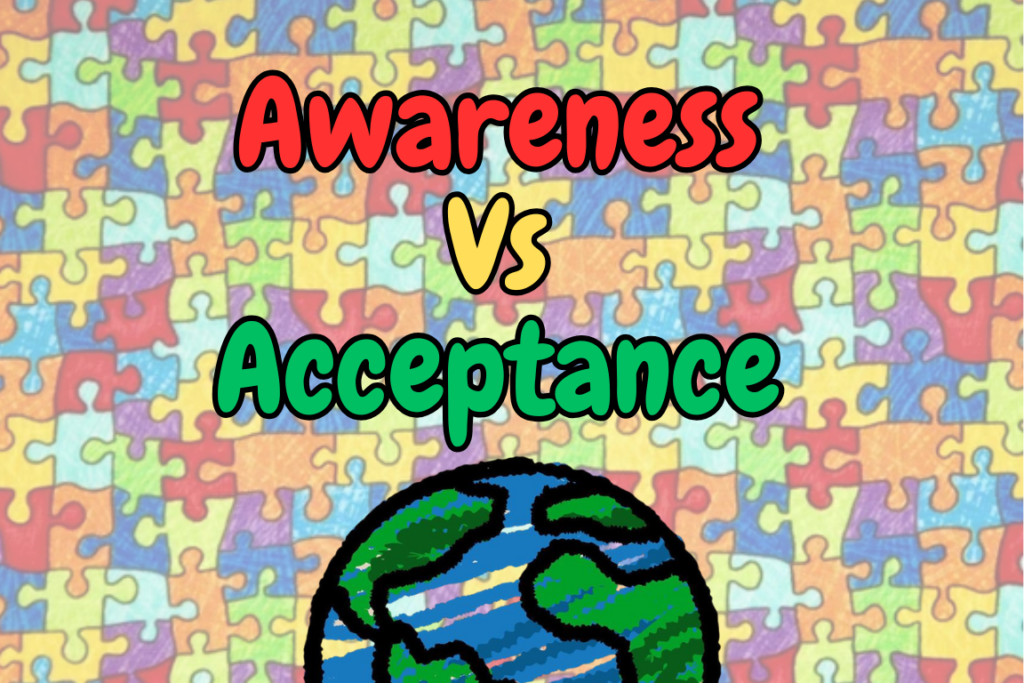
Let’s talk about the difference between awareness and acceptance.
Because there is one. And it matters.
In April, the world turns blue.
There are puzzle pieces, social media posts, and well-meaning campaigns that remind us to “be aware” of autism.
But here’s the thing:
We don’t need more awareness.
We’re already aware.
We know autism exists.
We’ve heard the word.
We’ve seen the headlines.
What we need now—what our children need—is acceptance.
Awareness says: “I see that you’re different.”
Acceptance says: “You belong exactly as you are.”
Awareness asks for understanding. Acceptance asks for change.
It’s one thing to know that autistic people exist. It’s another to change the classroom so they can thrive.
It’s one thing to say “I support you.” It’s another to show up when a child is melting down in public instead of staring or judging.
Acceptance is action.
It’s adapting the world with autistic people—not just for them.
It’s listening to autistic voices, valuing neurodivergent perspectives, and dropping the idea that “normal” is the goal.
Autism isn’t a problem to solve.
It’s a neurotype. A different way of processing, thinking, communicating, and existing.
Yes, there are challenges. And yes, support matters.
But the goal isn’t to fix autistic people—it’s to stop expecting them to mask, shrink, or suffer in silence to make others more comfortable.
My child doesn’t need to be made more palatable.
He needs to be accepted. Supported. Celebrated.
He needs to grow up in a world that doesn’t just tolerate him, but welcomes him.
Not despite his autism—but with it.
Awareness is passive. Acceptance is parenting.
As a parent, I’ve seen the difference firsthand.
I’ve watched people dismiss my child because “he doesn’t look autistic.”
I’ve heard comments that sting—about behaviour, eye contact, tone of voice.
I’ve seen how awareness fades after April, but the daily work of advocacy continues.
I don’t want pity. I don’t want performative allyship.
I want teachers, family members, neighbours, strangers at the playground to understand that my child’s needs aren’t inconvenient—they’re human.
Acceptance means:
- Making room for stimming instead of silencing it.
- Respecting communication that isn’t verbal.
- Recognising masking as trauma, not success.
- Believing autistic people—especially when they tell you what they need.
Autism acceptance means reimagining what inclusion really looks like.
Not fitting people into rigid systems.
Not praising them for “passing” as neurotypical.
But changing the systems. Opening the doors. Making space.
And maybe, in the process, we’ll all be a little freer.
So now that April is over, here’s what I’m asking:
Keep learning.
Keep listening.
Keep making space.
Choose to be the person who doesn’t need a campaign to care.
Choose to be someone who makes the world kinder, not just for autistic people—but because of them.
Because acceptance doesn’t come in a box of leaflets.
It lives in the everyday decisions to include, believe, and respect.
It lives in May.
And in June.
And in every moment after.
Like this post? Click below to share!
Read More...
What If It’s Not Defiance? Living with and Loving a PDA Child
What If It’s Not Defiance? Living with and Loving a PDA Child Parenting Outside the Lines means throwing away the rulebook—and sometimes rewriting it from
Beyond the Labels: Why Autism Isn’t a Straight Line (and Never Was)
Why Autism isn’t a Straight Line (and never was) Let’s get one thing clear right off the bat: autism isn’t a ladder, a hierarchy, or
Our Recommended Fidget Toys and Weighted Blankets
Our Recommended Fidget Toys and Weighted Blankets (Because sometimes, a little squeeze or a cozy hug makes all the difference.) If your household is anything
Our Must-Have Sensory-Friendly Clothing
Our Must-Have Sensory-Friendly Clothing (Because seams shouldn’t start screams, and socks shouldn’t ruin mornings.) Let’s be real: getting dressed shouldn’t feel like battle prep. But for sensory-sensitive
The Best Noise Cancelling Headphones
The Best Noise Cancelling Headphones (a.k.a. sanity savers) If I had a pound for every time a hand has flown to cover ears in this
Our Favourite Visual Schedules and Communication Boards
Our Favourite Visual Schedules and Communication Boards A round-up from one chaos-loving, neurodiversity-celebrating household to yours. If your mornings ever resemble a scene from a
